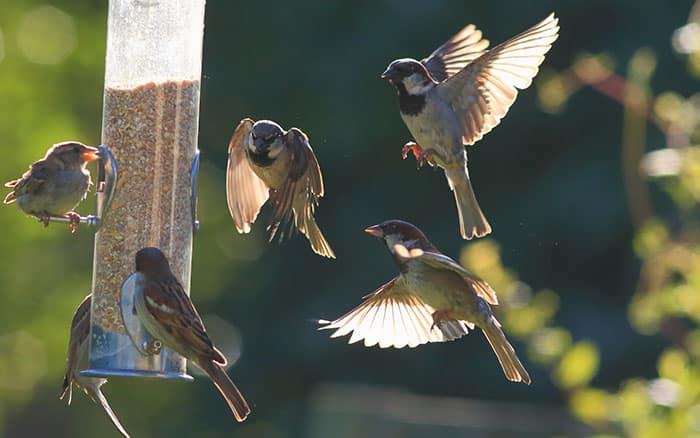Transform your garden into a wildlife friendly haven and then sit back and see which creatures pay your garden a visit.
It’s fascinating and there is loads to learn. So get the kids involved and find out if you can spot any of these garden guests. The ecosystem in your garden is so important, helping your flowers and foliage to flourish.
Brilliant birds
Invite birds into your garden by making fat-balls that provide food and a bird bath for them to drink from and wash in.
Feeding time
There are two types of bird feeders, one for ground feeding birds and one for those that prefer to be perched off the ground. Birds that prefer to feed off the ground buy or create a feeder that will be enjoyed by blackbirds, thrushes and wrens. Whereas sparrows, tits, finches and siskins will happily visit your seed feeders that are hanging from trees.

Plants for birds
Birds rely on plants to survive, for seeds as food or as a place to shelter and nest. So be sure to plant a few of their favourites that will keep them coming back.
Sorbus aucuparia (rowan) is a deciduous tree which fruits orange-red berries in early autumn which are taken quickly by blackbirds or starlings. Malus sylvestris (crab apple) has beautiful blossoms through spring and apple-like fruits in autumn which will attract robins, starlings, greenfinches and thrushes. A popular plant for pollinators, the blooms will attract bees in the spring too.
The bee’s knees

Our gardens are hugely important for pollinators such as bees. If we have the right variety of blooms in our gardens, we are giving them access to nectar and pollen. This is food and energy for them and the larvae back in their hives and nests.
In the UK there are more than 250 species of bee. And you can spot different bees at different times of the year. By opting for flowers that will flourish all year round, you’re giving them a helping hand.
Flower choices
Single, open flowers are great for bees because they can easily access the nectar and pollen. Although bees will be attracted to flowers in an abundance of colours, they can see purple most clearly. That makes lavender, alliums and buddleja brilliant blooms for bees.
Types of Bee
As its name states, the early bumblebee is the UK’s smallest bumblebee and starts nesting a few weeks before the majority of the other bumblebees. You can see these as early as March. Another common species you may spot from April is the red-tailed bumblebee with its black body and orange-red tail.
The honeybee is the insect that produces honey. They are social bees that live in colonies of up to 60,000. They produce honey by gathering nectar from flowers in our gardens.
Beneficial bugs
Bugs and insects are an essential part of the ecosystem in your garden. Some are predators to pests and others will help decay material in your compost heap.
You may see ladybirds fluttering around the garden. And these feast on aphids which can cause trouble on your strawberries, tomatoes, dahlias and sweet peas, among others.

Other Beetles
Ground beetles are black, sometimes metallic looking creatures that feed on soil-dwelling pests such as slugs and snails. You might find these around your log piles or compost heaps. Another bug you might find in your compost heap are springtails which help to breakdown organic matter.
Attracting amphibians

Having a garden pond will invite frogs, toads and newts to your garden. The common frog, common toad and common or smooth newt are most likely to visit British gardens.
Growing pond plants around the water will provide cover from predators whilst they are small and young. Allowing grass to grow over the edge of the pond will attract newts because they use narrow-leaved water plants to lay their eggs.
When they are not using the ponds, amphibians will want shelter over the winter months. If you have a log pile, adult amphibians may be using this spot as shelter, or beneath a hedge or compost heap.
Ensuring your pond is accessible by having gradual slopes or steps at the side allows other creatures, such as hedgehogs, to safely get in and out too, letting them drink and bathe safely.
Help the hedgehogs
As patron of the Hedgehog Preservation Society, I’m keen to spread awareness on how to care for these mammals. Fondly known as the gardener’s best friend.
The European hedgehog is one of the most familiar wild creatures in the UK. With their distinctive spine covered back, with the average hedgehog having about 7000 of the spines.

Hedgehog highway
Cutting a 13 x 13cm square in the bottom of your fence and encouraging your neighbours to follow suit will allow hedgehogs to move freely between gardens to access food and shelter.
Their natural diet includes bugs, slugs, snails and beetles among others. But you can give them a helping hand by leaving out some fresh cat or dog food, that is in jelly rather than gravy, and doesn’t contain fish.
There’s plenty you can do to encourage wildlife to your garden and make it a safe and secure place for them to visit, then sit back and see who pays you a visit. Let me know if you’ve spotted any of these creatures in your garden?

Leave A Comment